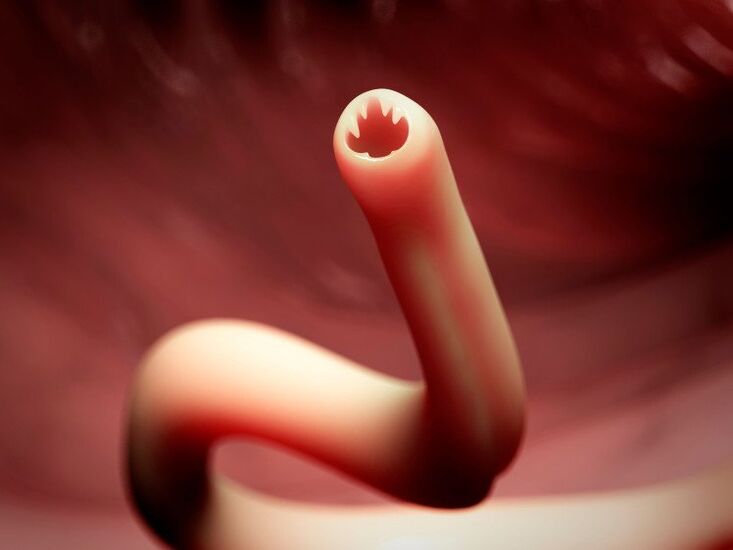
Worms or tapeworms are diseases that cover their journey quite well. Therefore, often a person does not cure a phenomenon that worsens health. Knowing the main signs of worms, you can accurately determine its presence or absence in the body.
The main thing to keep in mind is a proper assessment of the patient's condition and the specificity of the course of the disease. In order for treatment to run efficiently and in a timely manner, a detailed study of the manifestations of the worm is required.
How can you be infected with worms
Any adult can be a carrier of parasitic worms, and a child is also easily infected.
Helminths can enter the body in several ways, namely:
- air;
- food;
- relationships and households;
- autoinfection;
- spread.
The first route of infection is based on water intake, which contains worm eggs or larvae. The larva enters the water through an intermediate host, for example, a mollusk, and only then leaves its body and grows freely, attached to the aquatic plant. Once the fluid enters the body of a living being, the worm enters the digestive system and is already glued here.
This process often occurs in rivers, ponds, lakes, springs. To avoid contamination, you should stop drinking water in the open, especially for children. If the casing forces a person to absorb such water, then boiling or filtering through a special filter is a prerequisite.
Food ingress is the main and most common principle of infection. This is directly related to non -compliance of basic hygiene or violation of technology for preparing dishes from meat and fish. Helminths penetrate dirty hands, vegetables, berries, fruits, etc. Everything grown in the ground can contain worm eggs. They emerge there from the feces of patients with ascariasis and live in good condition for them for quite some time. The most likely infection is where the soil is fertilized with feces with the presence of ascaris eggs in it.

Larvae found in meat and fish enter the body along with improperly cooked food, not fully cooked. Once inside a person, the worm eventually develops into an individual capable of laying eggs on its own. It should be noted that in 24 hours one worm can produce several hundred thousand new eggs.
In order not to be infected and not to suffer from signs of worms, it is necessary to buy meat and fish only in inspected places, pay attention to the presence of veterinary controls, inspect the meat and especially the liver for the presence of worms. Boil also food (steam, fry), process kitchen utensils properly, protect the room from flies that can carry worm eggs on their feet.
The household contact method involves the penetration of worms through contact with household items, animals that have worm larvae. Statistics show that more than 70% of the earth’s population is infected with worms, half of this number is infected through contact with pets. This is dangerous because signs of the presence of worms in animals may not appear at all. But in humans, the symptoms of helminth penetration are expressed by nausea, constipation, vomiting, pain in the intestines, and weight loss.
Regarding self-infections, children are often vulnerable to them, especially kindergarten age children and younger school students. Children do not always follow the rules of hygiene, for example, after using the toilet. Helminthic invasion in infants is the development of enterobiasis. Cream worms have very light eggs, so they are transferred to toys, bedding, furniture with a gust of wind, and they can also get into the body with dust. When the worms in a child or adult reach puberty, they crawl out into the anal wall and begin the process of laying eggs. Itching and itching begins, these are the main signs of worm penetration. At night, the child can scratch the anus, and then insert the worm into his mouth again with his hands, in which case the cycle is repeated.
With regard to contagious infections, it should be said that the infection occurs as a result of insect bites. These can be mosquitoes, mosquitoes, fleas owned by pets. Often, infection occurs with filaments (filarias).

Symptoms of worms in adults
The presence of worms in the body can be recognized by special signs, but they can be different in people.
Manifestations such as features of severely infected patients:
- fatigue;
- weight loss (sudden change in weight loss);
- pale skin;
- severe itching in the anus.
Depending on where the helminths are and how many, certain symptoms develop.
In the brain
The first and foremost symptom, which indicates the presence of worms in the brain, is a deterioration of general well -being, and it is not permanent, but is temporary and cyclical in nature. The required measurement is a photo taken on an ultrasound machine, then the worm in the brain looks like a tumor.Symptoms also include:

- lethargy;
- feeling stunned;
- nausea along with vomiting;
- the disease causes seizures such as epilepsy;
- temperature rise for no apparent reason.
These symptoms are generalized; special studies will help see the picture that is happening more clearly.
In the body
Among all Earth parasites, more than 250 types of helminths can harm the human body. They can live in almost the entire body: heart, muscles, liver, under the skin, etc.
The symptoms of each case will be different, but there are still a number of common signs.
- weakness of the immune system;
- pain in joints, muscles;
- restlessness;
- fatigue that has developed into chronic;
- underweight;
- skin deterioration.
In the gut
Often, worms settle in the gut, more easily penetrate here and reproduce in such an environment. You can find out about the presence of "residents" by:
- recurrent bloating;
- diarrhea;
- weight fluctuations;
- bloated stomach;
- constant hunger.
Signs of worm appearance, as well as how to identify worms using tests and other diagnostic methods
When a person is infected with worms, symptoms may not appear at an early stage. You can see the signs of the appearance of worms in the house only when they start to multiply. The first sign begins when the body is poisoned, the parasite absorbs the nutrients a person receives with food.

Manifestations of helminths can be caused by symptoms such as:
- diarrhea;
- abdominal discomfort;
- bloated stomach;
- bloating;
- bile stasis;
- constipation;
- allergic manifestations;
- inflammation of the intestines;
- joint and muscle pain;
- dermatitis, eczema;
- brittle nails, cracks on the skin, discoloration of the skin;
- anemia;
- weight reduction;
- nervous system disorders, anxiety symptoms, trouble sleeping;
- grind teeth during sleep;
- excessive fatigue, loss of performance;
- respiratory problems: inflammation, pneumonia, asthma;
- weakness of the immune system;
- oncology (if helminthiasis is not treated for a long time).
Methods for determining worms
How to determine worms in a person, the doctor knows for sure, as a rule, for this, an examination is performed, which will help determine or rule out the presence of worms. Once the main stage (collection of anamnesis) is completed, a diagnostic procedure is set. Which study to determine depends on the severity of the symptoms and the type of helminthiasis. But it is very important to do tests so as not to infect people with worms.
Blood tests for parasites
Such analyzes are set to detect the presence of helminths. For its delivery, preparation is required, such conditions will allow a more accurate diagnosis. Moreover, the recommendation should be followed by both adults and children.
- carried out in the morning on an empty stomach;
- at least 9 hours must elapse from the last meal;
- you can drink water, not including its carbonated version;
- 3 days you need to adhere to a diet that should not contain salty, spicy, smoky foods;
- reduce physical activity and stress;
- stop using the drug for any purpose within 14 days.
It happens that the analysis does not show accurate results, moreover, there are signs of the appearance of worms. In this case, it is necessary to donate blood and feces again, and perhaps the next result will be positive.

Worms in feces
The presence of worms can be determined by the most common method - fecal delivery. Distinguish between coptogram and Kato methods. The first involves visual inspection of feces and chemical research. The Kato method shows whether there are worms visually, while the biological material, i. e. feces, is placed on a special glass.
Other signs of worms in children
To find out if a child has an infection, you need to pay attention to its appearance. Almost every parent knows how to determine the child's worms at home. For obvious signs of worm appearance, the following symptoms will indicate:
- dark circles under the eyes;
- pale appearance of facial skin;
- the body does not take food, there is a bad appetite;
- excessive saliva;
- vomiting, nausea;
- intestinal instability along with constipation, diarrhea, abdominal pain;
- dizziness;
- weakness;
- increased tears, sadness;
- itching in the anal area, worms can crawl, it can be seen with the naked eye;
- redness between the buttocks.
Helminthic invasion: symptoms according to the type of parasite and methods to combat them

Human infection with worms can occur in a variety of ways. Often due to poor hygiene or contact with worm carriers. Parasitic diseases are considered dangerous because they skillfully disguise themselves as other diseases. Therefore, the symptoms may indicate a disease, helminthic invasion, somewhat vague.
To find out the cause, various diagnostics are needed. Regarding treatment, this is individually, having an integrated approach, because it is important not only to identify the presence of helminths, but also to get rid of the consequences caused by their stay in the body.
When worms enter the human body, they consume all the essential components needed to function normally. With all of this, they also release toxic substances, negatively impact the immune system, and damage tissues and organs. If the disease is not treated in a timely manner, this leads to severe consequences, up to oncological diseases and even death.
Mark according to the type of worm
Depending on the case, helminthic invasion is characteristic of certain types of worms, as there are hundreds of their types. Cream worms are considered the most common, as infections can occur throughout the year. Each type of worm, whether round or tapered, is indicated by decreased immune system function, damage to internal organs, intoxication, allergies, etc.
Round
Ringworm or nematode is a dangerous helminthic invasion, the symptoms of which do not appear immediately in some cases. To remain comfortable in the human body, worms need oxygen, an appropriate temperature regime, a certain humidity. All this is in the human body.
The symptoms of this classification worm are very similar to the flu:
- traveling pain;
- a little nausea;
- violation of appetite;
- weakness throughout the body;
- stool disorders;
- inflammation of the abdominal wall and pain from this;
- acute allergies;
- drunk;
- if treatment is delayed, a violation of the working rhythm of all human organs develops.
The class of ringworms is quite broad, so the signs are also different. For example, with the development of enterobiasis, itching may appear in the anus, especially worsening at night. With ascariasis, the larvae actively move with the blood, so they can appear anywhere. Trichinosis develops in tandem with severe fever, muscle aches, swelling of the face, bright red rash, and so on.

Pita
Tapeworms are also divided into several types, including broad tapeworms, bovine tapeworms, echinococcus and others. Home remedies for this type of parasite are ineffective. Helminthic invasion and its symptoms are noted in certain cases.
Thus, with the widespread development of tapeworms in the body, it can:
- pressure in the pancreas;
- decreased stomach acidity;
- disturbed digestive processes;
- intestinal obstruction;
- lose weight;
- anemia;
- in severe cases during the disease, internal organs, high fever, numbness of the legs may increase.
With the development of tapeworms, similar symptoms are observed, frequent headaches are added, appetite increases or decreases sharply.
If echinococcosis, lungs and liver are damaged, muscles, brain, and bones tend to suffer. With liver damage, pain is observed in the right hypochondrium, heartburn, jaundice, cirrhosis. If the disease develops in the lungs, severe tuberculosis with blood impurities begins, shortness of breath. In the abdominal cavity, the development of this type of worm is very dangerous, as it can cause poisoning, allergies, peritonitis and severe anaphylactic shock.
Worm medicine for humans
Worm removal methods can be divided into drugs with narrow and diverse effects. The first type is based on the use of protivocestodozny drugs, the second - antihelminthics. The latter are most often prescribed, they are effective against parasites, stopping their growth and reproduction, and quickly removing them from the body.
A narrow spectrum is used depending on the circumstances and neglect of the case. Medications alone can endanger health and life! A visit to a specialist is a must.










